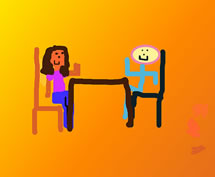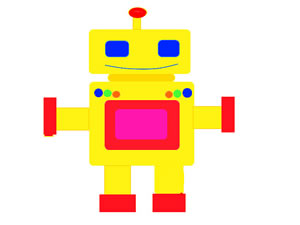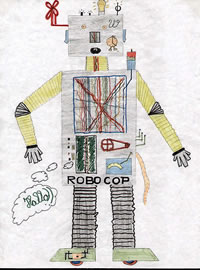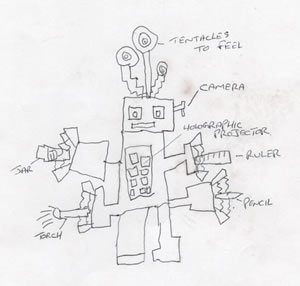
It’s common knowledge that many kids love the idea of robots, but does asking them to describe their dream robots lead to useful insight into how kids learn? According to a new study, the way kids view robotics can help schools design better 21st-century lessons and create more productive classrooms.
The study, titled “Robots @School,” was conducted by international research consultancy Latitude, and it asked children across the world to write and illustrate a short story answering this question: “What if robots were a part of your everyday life—at school and beyond?” (Download the full report as a PDF here.)
The goal, said Latitude reps, was to provide educators, entrepreneurs, technologists, and interactive content creators with insights about the close relationship between learning and play for today’s children, to “identify common frustrations in the learning process, and to suggest possible solutions—both high- and low-tech.”
While it includes some young students’ very cute robot drawings, the study also reveals a potential shift in kids’ “social and learning psychologies.”
“On the surface, this study is about robots but, more importantly, it’s about a new paradigm for learning and creativity, which kids—using robots as a focal point—are helping us to uncover,” said Steve Mushkin, founder and president of Latitude, in a statement. “Education and learning are moving, at least in many children’s eyes, beyond acts of knowledge transmission toward acts of exploration and creation. As participants in this new model, robots and other intelligent technologies could help unleash the inherent and expansive capabilities of each child in ways that we’ve only begun to conceive.”
Beyond cute drawings
Nearly 350 child innovators, ages 8-12, from Australia, France, Germany, South Africa, the United Kingdom, and the United States participated in the study, submitting drawings and text-based stories of their imagined experiences with robots.
For their stories, students were asked to discuss one of three narrative prompts: robots in the classroom, at school but outside of class, and at home after school. Researchers scored the stories based on “variables relating to human-robot relationships and the dimensions of human-robot activities (e.g., play, learning, creation, and exploration),” said the study.
According to the study, the stories revealed three key findings:
1. Smart machines are social machines. Nearly two-thirds of kids took for granted that robots could make great human friends. Most imagined them as human-like peers that they could “identify with and aspire to be like.” Also, being smart is cool, “giving children a solid motivation to learn. … This is, no doubt, also true in the real world (sans robots) for today’s digital natives—robots simply helped to illuminate what many kids already value in social scenarios.”
“Larry [the robot] said to me, ‘Look, math is an important part of your life and you will be using it a lot in the future. If you don’t do math now with me, I won’t be a close friend.’ I said, ‘Ok I will do it,’ so we raced each other with multiplication and he won but I got a better score than I got at school. Every time we did it I got better and started to kind of like maths. When we finished, I said to Larry, ‘Thanks for caring about me.’” —Girl, 11, Australia
2. Robots can be used to free up time and create in new ways. Kids imagined robots that were better versions of teachers and parents, offering “limitless time and patience, encouraging confidence and self-direction, and allowing us to make mistakes sans self-consciousness.”
“The robot is like a new friend for me. It helps me with my homework. It can do it much better than my parents because it knows exactly how to explain the lessons to a kid like me. The robot is very smart and can answer a lot of questions for me and tell me interesting stories. He always reminds me of all possible things, which I would have otherwise forgotten.” —Boy, 9, Germany
“While children imagine robots that are virtually human in many regards, it’s their slight machineness that ultimately makes robots such effective partners for learning and creative exploration,” said study leader Ian Schulte, director of technology and business development at Latitude. “Robots support and encourage, but don’t judge. They don’t run into scheduling conflicts, and they certainly don’t ostracize kids for wrong answers or unconventional thinking. Because they’re just mechanical enough, robots enable kids to grow and explore without regard for social stigmas that so often stifle learning and creativity.”
3. There’s little difference between learning and play. Kids focused an equal amount of attention between learning and play and didn’t make a large distinction between the roles of “playmate” and “study buddy.” (See also: “How to rekindle a love of learning in school.”)
“He made learning fun for me, by helping me to do my math and English. He then played with me at playtime. He’s much better at the monkey bars than me. Then we go back in and he helps me with my PE and he joins in with me.” —Boy, 11, United Kingdom
What can we learn from the study?
If robots could help students learn, perhaps educators and stakeholders can help them learn just as well.
Latitude researchers said they hope the study’s findings will offer today’s student’s assistance by:
- Making academic pacing feel more personalized for each child, with intelligent interactive technologies that feel genuinely “human.”
- Creating a more patient and accepting learning atmosphere by allowing technology—with its limitless time and “superhuman” tenacity—to sometimes fill the role of teacher.
- Leveraging kids’ “relevance filter” to emphasize to them the importance of gaining certain kinds of knowledge, with or without the help of technology.
- Offering opportunities for kids to learn in ways that feel more like play—such as through proactive, exploratory, open-ended projects that involve web technologies: activities that are increasingly valuable for developing internet-age competencies like sharing, remixing, and repurposing others’ work.
“Because robots do things (as if driven from within), they capture our imagination and are treated differently than inert objects; from transitional objects, they become alter egos,” said Edith Ackermann, an honorary professor of developmental psychology at the University of Aix-Marseille I in France and a visiting scientist at MIT’s Design Lab. “A child’s infatuation with robots is at the image of our own endless human quest for renewed identity.”
Read more at the Latitude Blog: http://latd.com/2012/01/16/robots-at-school-findings/.
- #4: 25 education trends for 2018 - December 26, 2018
- Video of the Week: Dealing with digital distraction in the classroom - February 23, 2018
- Secrets from the library lines: 5 ways schools can boost digital engagement - January 2, 2018





Comments are closed.